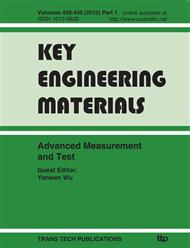[1]
P. T. Gonciari, B. Al-Hashimi and N. Nicolici, Improving compression ratio, area overhead, and test application time for system-on-a-chip test data compression/decompression, Proc. Design, Automation and Test in Europe Conf., pp.604-611, (2002).
DOI: 10.1109/date.2002.998363
Google Scholar
[2]
Kedarnath J. Balakrishnan, Emerging Techniques for Test Data Compression", Proceedings of the 14th Asian Test Symposium (ATS , 05), pp.54-54, (2005).
DOI: 10.1109/ats.2005.57
Google Scholar
[3]
A. Jas and N. A. Touba, Test vector decompression via cyclical scan chains and its application to testing core-based design, Proc. Int. Test Conf., pp.458-464, (1998).
DOI: 10.1109/test.1998.743186
Google Scholar
[4]
A. Jas, J. Ghosh-Dastidar and N. A. Touba, Scan vector compression/ decompression using statistical coding, Proc. VLSI Test Symp., pp.114-120, (1999).
DOI: 10.1109/vtest.1999.766654
Google Scholar
[5]
A. Chandra and K. Chakrabarty, System-on-a-chip test data compression and decompression architectures based on Golomb codes, IEEE Trans. Computer-Aided Design, vol. 20, pp.355-368, ( 2001).
DOI: 10.1109/43.913754
Google Scholar
[6]
A. Chandra and K. Chakrabarty, Frequency-directed run-length (FDR) codes with application to system-on-a-chip test data compression, Proc. VLSI Test Symp. pp.42-47, (2001).
DOI: 10.1109/vts.2001.923416
Google Scholar
[7]
P. T. Gonciari, B. Al-Hashimi and N. Nicolici, Improving compression ratio, area overhead, and test application time for system-on-a-chip test data compression/decompression, Proc. Design, Automation and Test in Europe Conf., pp.604-611, (2002).
DOI: 10.1109/date.2002.998363
Google Scholar
[8]
Lei Li and Krishnendu Chakrabarty. Test Data Compression Using Dictionaries with Fixed-Length Indices, Proceedings of 21 st IEEE VLSI Test Symposium, pp.219-224, (2003).
DOI: 10.1109/vtest.2003.1197654
Google Scholar
[9]
Wolff, F.G. and Papachristou, C., Multi-scan-based test compression and hardware decompression using LZ77, Proceedings. International. Test Conference, pp.331-339, (2002).
DOI: 10.1109/test.2002.1041776
Google Scholar
[10]
Masahiro Ishida, Dong Sam Ha. COMPACT: A Hybrid Method for Compressing Test Data, VLSI Test Symposium, 1998. Proceedings. 16th IEEE, 26-30. pp.62-69, (1998).
DOI: 10.1109/vtest.1998.670850
Google Scholar
[11]
Takahiro J, Yamaguchi. A Method for Compressing Test Data Based on Burrows-Wheeler Transformation, IEEE Transaction on computers, VOL. 51, No. 5. pp.486-489 , (2002).
DOI: 10.1109/tc.2002.1004588
Google Scholar
[12]
ZHENG Xi-feng , DENG Chun-jian, CHEN Yu, A Low Cost Method of Compression and Decompression, , CHINESE JOURNAL OF ELECTORN DEVICES. Vol. 31, No. 2, pp.397-398, (2008).
Google Scholar
[13]
V. Iyengar and A. Chandra, Unified SOC test approach based on test data compression and TAM design, , IEE Proc. -Comput. Digit. Tech., Vol. 152, No. 1, pp.86-88, ( 2005).
DOI: 10.1049/ip-cdt:20045030
Google Scholar


